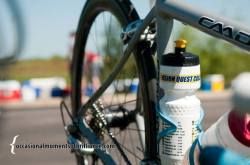If you can’t stand the heat…
We are coming into some of the year’s key races and with them the most intense heat of the summer. As we always say, race preparation needs to be as specific as possible in order to maximize your results. This specificity does not only apply to your workouts, but also the environmental conditions. If you are going to be racing in a hot environment, you also need to do at least some of your training in a hot environment so the body has a chance at acclimatization.
Several physiological changes take place within the body in response to heat. Evaporation of sweat from the skin is the body’s primary method of cooling. Blood flow is redirected away from the working muscles to vessels just below the skin where heat can more easily escape. This change in blood flow impairs the muscles’ ability to obtain oxygen and dispose of waste and also reduces cardiac filling. The latter effect comes along with a reduced stroke volume, requiring a compensatory increase in heart rate at any effort in order to maintain cardiac output. All of these conditions can diminish exercise performance.
The good news is that there are also corresponding adaptations to the above effects. Several adjustments take place within the first few days of heat exposure and acclimatization is nearly complete within 10-14 days, although it may take up to two months for complete adaptation to occur. The first changes to take place are those related to the cardiovascular system. Increased sodium retention helps to increase plasma volume. This helps to increase stroke volume as blood flow is split between skin and muscles and heart rate can return to normal levels. The next period of adaptation features thermoregulatory adaptations such as increased sweat rate, earlier onset of sweating and less sodium lost through sweat. As these thermoregulatory adaptations reach their peaks, the cardiovascular adaptations begin to fade away since they are no longer necessary.
The time for complete acclimatization to take place varies among individuals. Athletes with higher levels of fitness will tend to adapt faster because their bodies are accustomed to the internal heat stress that occurs during normal training. Less fit athletes have not subjected themselves to the same degree of stress, so adaptation will be a bit slower. Climate also has an effect on adaptation, with differences appearing between hot-humid and hot-dry environments. This is because high humidity prevents effective sweat evaporation, so cooling is less effective than it would be in a dry environment at the same temperature.
In order to foster adaptation, it is necessary to spend gradually more time exercising in the heat. Passive heat exposure (like saunas) has been shown to be much less effective for inducing heat acclimatization. Initially, exercise sessions should be kept relatively short and be completed at lower intensity. As you near the end of the initial 10-14 day adaptation period, workout duration should gradually return to normal. Once adapted, you should be ready to resume normal training in terms of both volume and intensity. It is not necessary to exercise in the absolute hottest parts of the day, but training should be done in conditions that are warmer than normal.
Excess fluids and electrolytes will do nothing to help speed up the acclimatization process, but dehydration and insufficient electrolyte replacement can negate the adaptations the body is trying to complete. Although excesses are not helpful, acclimatization will result outdoors, athletes needing to artificially create heat stress should wear heavier clothing that will increase sweat rate while still permitting normal evaporation to occur.
The next time you need to compete in the heat, remember these three key points:
1. Adaptation requires about 10-14 days.
2. You need to spend more time exercising in a warm environment.
3. Include adequate fluid and electrolytes to support adaptation, but not too much.

